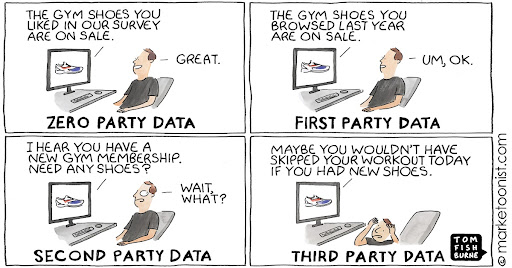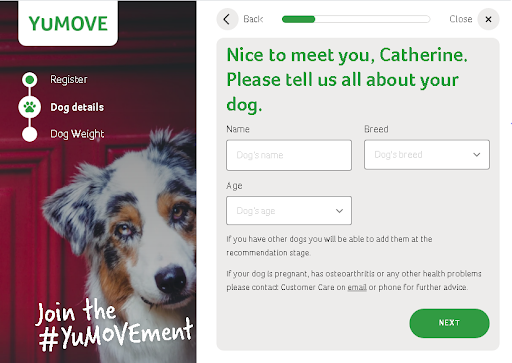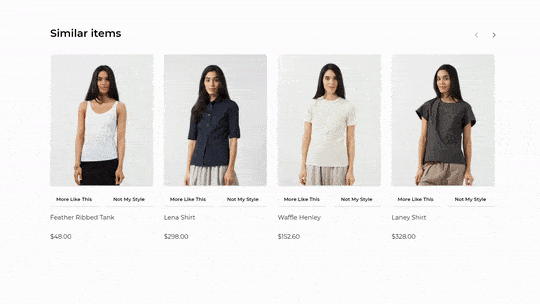How to Use Zero-Party Data to Personalise Your Customer’s Shopping Experience
Today’s article features the expertise of Skafos’ Michael Hall. Join him as he explores the best ways to personalise your brand’s ecommerce experience using zero-party data, including emerging technologies like interactive recommenders.
Written By
Guest Blogger

Customers will offer their data freely if it’s clear how you’ll use it to make their shopping journey more enjoyable.
What is zero-party data?
A phrase that is sure not to have escaped you in 2021, “zero-party data” has become one of marketing’s biggest buzzwords this year. But what does it actually mean?
Zero-party data is information that a customer intentionally shares with a company. In the context of ecommerce, zero-party data is commonly collected through mediums such as surveys, product quizzes, as well as through loyalty programs, and the creation of customer accounts.

Why is it important to embrace zero-party data?
Personalisation in e-commerce falls into many categories, including:
- Behavioural
- Contextual
- Technical
- Historic data
- Collaboratively filtered
While not all of these categories require historical or personal data, many personalisation techniques that have taken root for ecommerce have relied on customer profiling through tracking pixels and cookies, and historical purchase data. Product recommendations, for example, suggest relevant products to users based on products they have already searched for or purchased on your site.
However, as we see a growing number of data breaches, a trend is emerging where users are more selective about what data businesses store about them. We want control of our own data and our privacy to be respected. And, as the adage says, “the customer is always right”.
This is why you’re seeing Big Tech moving to provide more stringent data protections for their customers. Examples include Apple’s recent announcement that they were removing pixel tracking in their operating system and giving their users more control over their data.1 We will see this grow amongst other tech businesses, as well as government regulators designing policies that protect consumers’ data.
This doesn’t mean that shoppers do not want personalised experiences but, rather they desire them on their own terms. This is where zero-party data comes into play.
Best ways to use zero-party data to personalise your ecommerce experience
While the industry is still evolving with the market, you can get ahead of this with tools and techniques already available today. Here are a few considerations for you and your team as you begin your zero-party data strategy:
#1 Surveys
This is the simplest form of data collection, in that you are creating a set of questions for your customer to answer in order to understand their relationship and desires when they engage with your brand. Swanky’s design team use surveys as part of our website discovery phase, to help us understand how customers are interacting with a website and where there are areas for improvement. For a good example of surveys in action, look to online personal styling service Stitch Fix who use these to help their stylist understand what their customers want.
You can do implement surveys through forms that are on your site, using apps readily available on the Shopify app store, or through email and other pop-ups on your site, using tools such as Typeform.
PROS
- Easy to implement
- Customers understand how to use them
CONS
- Captured data needs to be integrated into an analysis or re-marketing process
- Does not personalise the core customer experience
#2 Quizzes
Quizzes could be considered surveys with a recommender at the end! These are great as pop-ups, or within the homepage, or as callouts through the shopping journey in that they help the shopper find what they want by giving you feedback in real-time.
For some quiz inspiration, take a look at leading pet supplement brand YuMove who, with the help of Swanky, have implemented an interactive quiz to ask first-time customers questions about their pets and their individual needs. The brand are then able to suggest the most suitable products, as well as promote relevant content that provides value to the customer.

Courtesy of YuMOVE.
A popular provider of quizzes and conversational pop-ups on Shopify is Octane AI, but there are certainly others on the app store to choose from.
PROS
- Customers understand how to use them
- Shopify has many apps for you to try
- Data shows that they do work
CONS
- Expert-systems require you to develop and maintain workflows
- Limited to what you want the customer to see
#3 Loyalty programs
Now is where things become interesting. Surveys and quizzes are great ways to start to ask your shoppers for data to personalise their experiences, but wouldn’t it be better to create longer, lifetime customers? Loyalty programs do this by providing more value in exchange for a customer offering more of their information over time. This is mostly achieved through a points system that rewards your shoppers as they buy more products from you.
As they become more engaged, brand loyalty rises as they are also investing in you. Using this information you can provide very personalised specials or deals and also encourage them to invite their friends.
Again, Shopify has many apps for you to try but a popular one is smile.io which also integrates with Shopify POS.
PROS
- Customers understand how to use them
- Shopify has many apps for you to try
- Data shows that they do work
- Can grow customer lifetime value
CONS
- Take time and effort to design and manage
- Works best with brands whose products and services are more lifestyle categories
- Requires nurturing and commitment by brands to create successful programs
#4 Interactive recommenders
Interactive recommenders use social media metaphors such as likes and dislikes to apply gamification to product discovery while giving shoppers agency. Mimicking how humans shop in brick-and-mortar stores, interactive recommendations act like an in-store sales associate by asking consumers what they like and dislike.
AI algorithms process customer feedback in the moment, letting the shopper control their own journey. The advantage of this is that you do not need to know anything about your shopper to be effective. However, as the shopper continues to interact with your catalogue they are providing valuable zero-party data about who they are.
Bottom line, interactive recommenders blends quiz-like features with social media paradigms to further improve recommendations that, until now, were simply guesses.
This information can also be used in remarketing campaigns and to better understand your products from a merchandising perspective (product sentiment).

PROS
- Easy to install
- Works extremely well with little customer data
- Use interactions to provide context for better recommendations
- Capture customer data quickly
CONS
- It’s a new experience and not mainstream for shoppers
- Sometimes they work too well and while conversion rate and revenue per visitor rise, average order value slightly falls
- Limited use cases to date
PERFORMANCE
As with all new technologies, it takes trial and error to fine tune what’s going on behind-the-scenes with interactive recommenders. And, even then, it’s a continual evolution as marketing channels mature. Think about email or traditional recommendation systems – interactive recommenders are no exception.
What’s next for zero-party data?
We’re still in the early stages of the “zero-party data” era, and as ecommerce continues to grow rapidly, data privacy will be taken more seriously. Which is great news! We are customers too, after all.
As data and privacy regulations tighten, we will see even more emphasis placed on asking our customers permission to store their personal information and use it for the specific purpose of providing a better customer experience for them. To be most effective here, we need to embrace zero-party data and be prepared to experiment with emerging technologies to find what works best for our brands and our customers.
Happy conversions!
For reference:
[1] https://www.apple.com/newsroom/2021/06/apple-advances-its-privacy-leadership-with-ios-15-ipados-15-macos-monterey-and-watchos-8/

